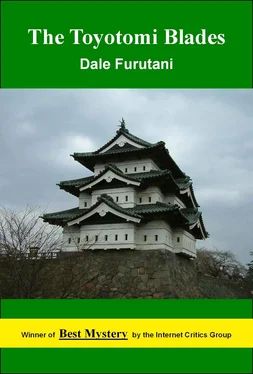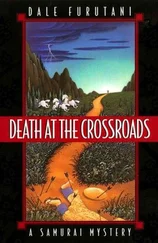Dale Furutani - The Toyotomi Blades
Здесь есть возможность читать онлайн «Dale Furutani - The Toyotomi Blades» весь текст электронной книги совершенно бесплатно (целиком полную версию без сокращений). В некоторых случаях можно слушать аудио, скачать через торрент в формате fb2 и присутствует краткое содержание. Год выпуска: 2012, Жанр: Криминальный детектив, на английском языке. Описание произведения, (предисловие) а так же отзывы посетителей доступны на портале библиотеки ЛибКат.
- Название:The Toyotomi Blades
- Автор:
- Жанр:
- Год:2012
- ISBN:нет данных
- Рейтинг книги:4 / 5. Голосов: 1
-
Избранное:Добавить в избранное
- Отзывы:
-
Ваша оценка:
- 80
- 1
- 2
- 3
- 4
- 5
The Toyotomi Blades: краткое содержание, описание и аннотация
Предлагаем к чтению аннотацию, описание, краткое содержание или предисловие (зависит от того, что написал сам автор книги «The Toyotomi Blades»). Если вы не нашли необходимую информацию о книге — напишите в комментариях, мы постараемся отыскать её.
The Toyotomi Blades — читать онлайн бесплатно полную книгу (весь текст) целиком
Ниже представлен текст книги, разбитый по страницам. Система сохранения места последней прочитанной страницы, позволяет с удобством читать онлайн бесплатно книгу «The Toyotomi Blades», без необходимости каждый раз заново искать на чём Вы остановились. Поставьте закладку, и сможете в любой момент перейти на страницу, на которой закончили чтение.
Интервал:
Закладка:
“I recognize you from the picture,” Sugimoto added in slightly accented English, “or else I’d be holding up one of the little cardboard signs with your name on it. Is that all your luggage? I have a car waiting outside.”
Sugimoto took over my luggage cart and wheeled it out of the terminal with me in tow. Outside, there was a black limousine waiting at the curb. The driver was in a blue uniform, wearing white cotton gloves. He had a feather duster in his hand and he seemed busy dusting off the car. The car was a Nissan President, a model they don’t sell in the States. Sugimoto spoke to the driver in Japanese and opened the door of the limo for me. “The driver will take care of your luggage,” Sugimoto said as I climbed into the car. The seats of the car had white lace doilies pinned to the headrests. It looked very Victorian.
“How long will it take us to get to the hotel?” I asked Sugimoto.
“It’s rush hour now. It will take us at least two hours, maybe longer. If you don’t mind, I’d like to stop at the studio before we check you into the hotel. We’d like to film a short promotional spot with you for next week’s show.”
The news that it might take over two hours to get to Tokyo made me wish that I’d used a bathroom before leaving the terminal, but the driver was already in the car and pulling away from the curb before I could say anything.
It was late afternoon Japan time, which made it very late at night in Los Angeles, and my body was still on Los Angeles time. The thought of stopping at a studio to film some promo was not as inviting as the thought of checking into the hotel and sleeping. Still, I figured it would be churlish not to let News Pop make its promotional piece. After all, they had flown me to Japan to be on the show, not for my sparkling personality. I told Sugimoto that stopping at the studio would be fine.
“Did you bring the sword?” Sugimoto asked.
“Yes. It’s in that large gym bag.”
“And that’s the sword used in the murder you solved?”
“No,” I said, surprised. “The murder sword is a piece of evidence, so it’s being held by the Los Angeles Police Department. This sword is one that I bought for a hundred dollars at a garage sale.”
“It’s not the murder sword? When we saw the photograph we naturally assumed that the sword you were holding was the one used in the murder.”
“I’m afraid not. It’s just a prop that the Asahi Sbimbun photographer thought would add interest to the picture.”
“Damn!” Sugimoto thought a few seconds, and said more to himself than to me, “Never mind. If we made a mistake thinking it was the murder sword, others might make the same mistake. We’ll still use it as a prop in the promotional piece. Have you ever been on television before?”
“No, I haven’t.”
“Well, don’t worry. Our show has live interviews, but we do interviews with people who aren’t professionals all the time. During the interview we’ll run a simultaneous translation from Japanese to English through an earpiece, so you’ll understand the questions that our hosts ask you. You’ll respond in English, naturally, and we’ll do a simultaneous translation for our audience. Prior to the live interview we’ll discuss the types of questions we’ll ask you, so although your responses will be spontaneous, there will be no surprises. The lead-in piece, which sets up the interview, will be on tape. We’ll need your help in putting together that piece, so we’d like you to check in at the studio for about an hour every day. The late afternoon is best, which will also give you most of the day for sightseeing. Do you have any questions?”
“No. You must give that little speech a great many times,” I said.
Sugimoto laughed. “I’m sorry if I sound a little like a recording. I do give that speech a lot.”
“Do you meet many people at the airport?”
“Quite a few. It’s part of my job when I’m in town. Half the time, I’m traveling to the U.S. or Europe to track down stories. In fact, I just got back from Europe a few days ago. I’m not always here to meet our guests, but it’s actually something I enjoy because I get to know a great many people.”
“How long have you been doing this kind of work?”
“About seven years. I’ve been doing it for News Pop for three years. Before that I worked with other shows, including NHK News.”
We made small talk as we drove along, but my attention soon turned to the view out the car window during the long drive from Narita to Tokyo. I saw a lot of roofs made with blue tile or tin sheets, and the houses were very small and narrow even when they were built near Narita, where there seemed to be more open space. Small houses crowded together is hardly an original observation about Japan, but when you see it for yourself you realize that many facets of the Japanese standard of living simply haven’t kept up with their vaunted technical and business prowess.
Traffic increased as we approached Tokyo. Sugimoto pointed out Tokyo Disneyland off the freeway and said we had at least another hour to go, but frankly, by that time, my thoughts were more focused on my bladder than the Japanese version of a Southern California tourist attraction. I really should have gone to the bathroom before we left the airport.
5
We crawled through bumper-to-bumper traffic. There seemed to be no lane discipline with Tokyo drivers, and cars were often five abreast where there were just three lanes painted on the pavement. In Japan, of course, they drive on the left side of the road like the British, and it was a little disorienting to see drivers on the “wrong” side.
It took us almost two and a half hours to reach the television studio from Narita, and when we finally got there I was desperate. We pulled up to what looked like a side entrance to the studio and when we got out of the car, Sugimoto asked me to take the prop sword out. Instead, I told Sugimoto, “I have to use a restroom. Now. Right away. Immediately.”
“No problem,” Sugimoto said, and led me to a small bathroom off the entrance. As soon as I walked into the bathroom, I knew there actually was a problem.
In the room there was no toilet and no urinal. There was a sink and in the tile floor there was a fixture that baffled me. It looked like a white porcelain version of the kind of slit trenches we used for field latrines in the army, but with a raised lip at one end. It was about eight inches wide and two feet long. I stared at it for several minutes trying to figure out what the hell it was.
Embarrassed but in need of immediate guidance, I stuck my head out of the door and asked Sugimoto, “How are you supposed to use this thing?”
Sugimoto laughed and said, “That depends on what you want to do. Why don’t I take you to a Western-style toilet? Sometimes the Japanese-style toilets can be confusing.”
“I’m not totally confused, but I do want to know if what I’m about to do is the right thing. I thought I’d just straddle that trench in the floor and take careful aim. Is that right?”
“You got it,” Sugimoto said.
I went back into the toilet and did a reasonably neat job. When I finished I stared at the fixture in the floor, trying to fathom how you would use it if you needed it for other bodily functions or if you were a woman. The possibilities I came up with all involved straddling, squatting, and other undignified maneuvers. I had just received my first prosaic lesson in the differences between the familiar and the proverbial mysteries of Asia.
When I was done, I retrieved the samurai sword from my luggage and followed Sugimoto up to the News Pop studio, which was on the seventh floor of the building.
Читать дальшеИнтервал:
Закладка:
Похожие книги на «The Toyotomi Blades»
Представляем Вашему вниманию похожие книги на «The Toyotomi Blades» списком для выбора. Мы отобрали схожую по названию и смыслу литературу в надежде предоставить читателям больше вариантов отыскать новые, интересные, ещё непрочитанные произведения.
Обсуждение, отзывы о книге «The Toyotomi Blades» и просто собственные мнения читателей. Оставьте ваши комментарии, напишите, что Вы думаете о произведении, его смысле или главных героях. Укажите что конкретно понравилось, а что нет, и почему Вы так считаете.












